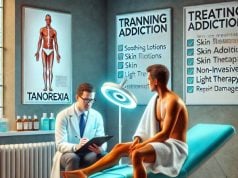
Skin picking disorder—also called excoriation or dermatillomania—is far more than a quirky habit. For millions, the urge to squeeze pores, remove scabs, or hunt for imagined blemishes feels magnetic, unstoppable, and oddly soothing. Minutes stretch into hours; tiny nicks become raw wounds; shame mounts each time someone notices. Yet behind the bandages sits a medical condition rooted in brain circuitry, stress, and learned relief loops—not lack of willpower. This guide explores how common the struggle really is, what drives it, how to spot early red flags, and, most importantly, how science-backed care can lead to calmer skin—and mind—over time.
Table of Contents
- Epidemiology Snapshot and Global Trends
- Root Causes: Genetics, Emotions, and Surroundings
- Telltale Behaviors, Symptom Checklist, and Assessment
- Physical Complications and Quality-of-Life Costs
- Therapeutic Interventions and Recovery Roadmaps
- FAQ
Epidemiology Snapshot and Global Trends
Excoriation disorder hides in bathrooms, bedrooms, and office cubicles worldwide. Population surveys place lifetime prevalence between 1.5 and 5 percent—meaning that in a crowded subway car, several riders could be concealing freshly picked skin beneath sleeves or makeup. Rates climb to roughly 12 percent among dermatology patients, suggesting many first seek help for wounds rather than the underlying compulsion.
Age of onset skews young: more than half report the habit starting around puberty, when acne, hormonal shifts, and social comparison peak. A second spike appears in the mid-20s to early-30s—often linked to adult acne flare-ups, pregnancy-related skin changes, or career stress.
Gender distribution is surprisingly balanced. Earlier studies reported a female majority, but newer community-based research finds men under-disclose. Cultural norms make it easier for women to talk about skincare; many men quietly pick scalp scabs, beard ingrowns, or calluses instead.
Digital influence accelerates spread. High-definition mirrors on smartphones, “pimple-popping” videos, and skin-zoom filters amplify flaw awareness. Social media groups can be double-edged: peer support exists, yet trigger images circulate freely, normalizing lengthy picking sessions.
Co-occurrence elevates visibility in clinic charts. Roughly 30 percent of people with obsessive-compulsive disorder (OCD) and up to 20 percent with trichotillomania (hair pulling) also report chronic skin picking. Such overlap helps clinicians spot excoriation earlier—yet many sufferers drift for years between dermatologists and mental-health providers before receiving a clear diagnosis.
Why these numbers matter: they erase the myth that “nobody else does this,” opening doors to empathy, research funding, and insurance coverage.
Root Causes: Genetics, Emotions, and Surroundings
Skin picking disorder does not arise from vanity or laziness. It is a complex feedback loop involving biology, psychology, and environment.
Neurobiological foundations
- Dopamine and reward learning. The brief relief or satisfaction after removing a “flaw” triggers a dopamine pulse in the brain’s reward center. Over time, neural pathways learn: “See bump, feel tension → pick → dopamine hit.”
- Glutamate imbalance. Some imaging studies suggest heightened glutamatergic activity in cortical-striatal circuits—similar to other obsessive-compulsive related disorders—fueling repetitive motor behavior.
- Sensory processing quirks. Many pickers report tactile hypersensitivity: tiny irregularities on skin feel huge, demanding removal. Others are hyposensitive—needing extra stimulation to register touch, so picking supplies needed sensory input.
Psychological drivers
- Emotion regulation gaps. Anxiety, boredom, or frustration often precede a picking episode. Physical focus displaces emotional discomfort—an externalized coping strategy.
- Perfectionistic thinking. Beliefs like “Smooth skin means I’m okay” push relentless scanning for micro-imperfections.
- Dissociation and trance. Some describe slipping into a semi-hypnotic state; minutes vanish, only discovered when fingertips sting or blood appears.
- Early modeling. Watching a family member squeeze pimples or chew cuticles can normalize grooming-turned-compulsion.
Environmental accelerants
- Mirrors and bright lighting. Flaw-seeking thrives under magnifying mirrors, fluorescent bathrooms, or ring lights used for makeup tutorials.
- Idle hands zones. Long commutes, streaming marathons, or conference calls offer the perfect storm of stress + boredom + privacy.
- Dermatological triggers. Acne, eczema, psoriasis, insect bites, and even dry winter skin create pickable scabs and scales.
- High stakes social settings. Weddings, job interviews, or first dates raise appearance anxiety, increasing scanning and “emergency fixing.”
Key takeaway: Excoriation arises where genetic sensitivity meets psychological tension and environmental temptation—so treatment must address all three layers.
Telltale Behaviors, Symptom Checklist, and Assessment
Because the hands are quick and the marks hide beneath clothing or makeup, excoriation often flies under the radar. Spotting patterns early improves outcomes.
Observable habits
- Stationing magnifying mirrors or tweezers in multiple rooms.
- Scouting skin with fingernails during phone scrolling or reading.
- “Just checking” bumps that escalates into prolonged digging for a perceived core.
- Collecting tissue, alcohol wipes, or needles—ritualistic toolkits for sessions.
- Frequent trips to bathroom or parked car after stressful conversations.
Common self-assessment questions
- Do you lose track of time while picking, even when appointments loom?
- Have wounds lingered longer than one week because you reopen them?
- Do you avoid swimming, dating, or sleeveless clothes to hide lesions?
- Have you failed repeated promises to stop—even after scarring?
If “yes” echoes through those questions, a professional evaluation is warranted.
Clinical diagnostic route
- Structured interview. The Skin Picking Scale-Revised (SPS-R) or Milwaukee Inventory for the Dimensions of Adult Skin Picking (MIDAS) quantifies severity and triggers.
- Rule-out medical mimics. Dermatologists exclude scabies, impetigo, or autoimmune blistering diseases first.
- Comorbidity screening. Tools for OCD, body dysmorphic disorder (BDD), ADHD, and mood disorders guide integrated care.
- Functional impairment check. Clinician documents time lost, wound care expenses, and social avoidance to stage mild, moderate, or severe.
Insurance coding tip: Excoriation disorder owns a DSM-5-TR code (698.4), boosting coverage legitimacy. Many clients see improved reimbursement when this term is explicitly used.
Physical Complications and Quality-of-Life Costs
At first glance, skin picking seems a cosmetic issue. Over months or years, consequences extend deep under the surface.
Dermatological and medical risks
- Infections. Staphylococcal or streptococcal cellulitis can require antibiotics or hospitalization; MRSA risk rises with repeated breaches.
- Scarring and dyspigmentation. Ice-pick pits, hypertrophic scars, and post-inflammatory hyperpigmentation alter texture and tone—sometimes permanently.
- Nerve damage. Aggressive digging near nail beds or facial nerves can cause numbness or neuropathic pain.
- Ocular injury. Some pickers target eyelid margins or lashes, leading to blepharitis and vision disturbances.
Mental-health toll
- Shame spiral. Visible lesions invite comments; each remark magnifies self-contempt, which fuels more picking.
- Anxiety and depression. Constant vigilance over lighting, clothing, and social plans exhausts emotional reserves.
- Body image distortion. Focus narrows to pores and scabs, crowding out appreciation for the body’s broader capabilities.
- Dissociation episodes. Extended “trance picking” can mimic out-of-body states, unsettling cognitive health.
Social and functional fallout
- Relationship strain. Partners may misinterpret picking as self-harm or find blood stains distressing.
- Workplace hurdles. Makeup breaks, bandage changes, and doctor appointments eat into productivity and confidence during presentations.
- Financial burden. Dermatology copays, scar creams, and cosmetic camouflage accumulate over years.
Bottom line: Excoriation silently erodes physical comfort, emotional resilience, and social ease—making timely treatment a health imperative, not a vanity project.
Therapeutic Interventions and Recovery Roadmaps
There is no single “stop-picking pill,” but layered strategies lead to significant, lasting improvement. Think of recovery like skincare: consistent routines beat miracle fixes.
Evidence-based psychotherapies
- Habit Reversal Training (HRT). Teaches awareness of early urge cues and installs competing responses—e.g., clenching fists or stroking a textured stone for one minute before reassessing urge intensity.
- Cognitive Behavioral Therapy (CBT) with Stimulus Control. Identifies “permission thoughts” (“Just one squeeze”), challenges distortions, and restructures environments—covering mirrors, limiting tweezers to locked boxes, or using dimmer bulbs.
- Acceptance and Commitment Therapy (ACT). Helps clients accept uncomfortable sensations and urges without acting, anchoring actions to values like “caring for my skin.”
- Dialectical Behavior Therapy (DBT) skills. Distress-tolerance techniques (ice-holding, paced breathing) provide in-the-moment alternatives when tension peaks.
Pharmacological aids
- SSRIs (e.g., fluoxetine, sertraline). Reduce obsessive thoughts and overall anxiety, indirectly lowering pick frequency.
- N-acetylcysteine (NAC). An over-the-counter amino-acid derivative; studies show 1,200–3,000 mg daily modulates glutamate and cuts urges in many users.
- Lamotrigine. A mood stabilizer helpful when skin picking co-occurs with bipolar spectrum or severe impulsivity.
- Topical anesthetics. Lidocaine gel diminishes pleasurable or relieving sensations from picking certain areas, weakening reward.
Dermatological collaboration
- Gentle cleansers, non-comedogenic moisturizers, and hydrocolloid patches shield healing skin.
- Silicone gel sheets or laser therapy fade established scars, boosting morale and motivation.
- Derms coordinate with therapists, sharing wound photos to track progress objectively.
Digital and self-help tools
- App-based trackers. SkinPick, HabitAware’s Keen bracelet, or Bearable log episode times, triggers, and streaks.
- Fidget substitutes. Textured sensory rings, putty, or velvet patches adhered to phone cases keep hands busy.
- Barrier garments. Cotton gloves at night, long-sleeved pajamas, or breathable bandages reduce unconscious picking.
Relapse-resistant lifestyle plan
- Morning scan. Check skin under soft light for medical issues only—no squeezing—and apply moisturizer to minimize rough textures.
- Stress outlets. Schedule 30 minutes of cardio, yoga, or drumming to discharge restlessness.
- Urge-rating scale. 0–10 quick notes in phone; intervene with coping skill if number hits 6.
- Weekly reflection. Journal what triggered high-score days; refine strategies—perhaps adding a desk lamp filter or pausing true-crime shows that heighten tension.
- Celebrate skin kindness. Mark pick-free days with non-appearance rewards: new book, call with a friend, hiking trail.
Success vignette
Jada, 26, picked facial acne until scabs dotted her cheeks. She joined an eight-session HRT group, replaced her magnifying mirror with a frosted stick-on, and wore silicone finger covers during TV time. NAC supplements plus CBT homework shrank episodes from 2 hours nightly to 10-minute slips twice a week within three months. One year on, she glows makeup-free at brunches, noting, “I still feel an urge sometimes, but it no longer runs my day.” Her story echoes thousands: with multifaceted support, hands can learn gentler habits.
Essential message: Recovery combines brain-targeted medication, skills training, environmental tweaks, and compassionate perseverance—turning relentless picking into manageable, occasional urges.
FAQ
Is skin picking disorder the same as OCD?
No, but they are cousins. Excoriation sits in the obsessive-compulsive spectrum. Many people have both, yet skin picking can exist alone with its own treatment plans.
Can children outgrow picking on their own?
Some do, especially if episodes are mild and tied to transient stress. Persistent, scarring, or daily picking typically needs early intervention to avoid lifelong patterns.
Does acne medication cure the disorder?
Dermatology treatments help by reducing blemish triggers, but the picking urge often persists. A combined skin-care and behavioral approach works best.
Is wearing gloves all day a long-term solution?
Gloves can break automatic cycles temporarily but should pair with therapy; otherwise, urges may shift to other body areas or reappear once gloves come off.
How quickly does N-acetylcysteine work?
Some notice reduced urges within two weeks; others need eight to twelve. Always consult a healthcare provider for dosage and interaction guidance.
Will stopping picking make scars disappear?
Fresh lesions heal dramatically once left alone. Older scars may fade slowly or need treatments like silicone gel, microneedling, or lasers for best results.
Is skin picking considered self-harm?
Intent matters. Most pick for relief or satisfaction, not to punish themselves. However, severe cases can blur into self-injury territory and deserve careful assessment.
Can I still get manicures or facials during treatment?
Yes, if they reduce urge triggers and boost self-care. Ensure estheticians understand gentle techniques to avoid new scabs.
Does meditation really help?
Mindfulness practices lower baseline anxiety and increase awareness of urges before hands act. Many clients credit daily five-minute sessions with big progress.
Where can I find specialized help?
Search online for “body-focused repetitive behavior (BFRB) therapists” or visit organizations like the TLC Foundation for Body-Focused Repetitive Behaviors for provider lists.
Disclaimer: This content is intended for educational purposes only and should not replace personalized medical or mental-health advice. If you or someone you know struggles with skin picking disorder, consult qualified healthcare professionals.
If this article shed light on excoriation disorder, please share it on Facebook, X (formerly Twitter), or any platform you enjoy. Your support helps us continue creating compassionate, evidence-based resources. Follow us for more insights—you might be the spark that inspires someone else’s healing journey.










